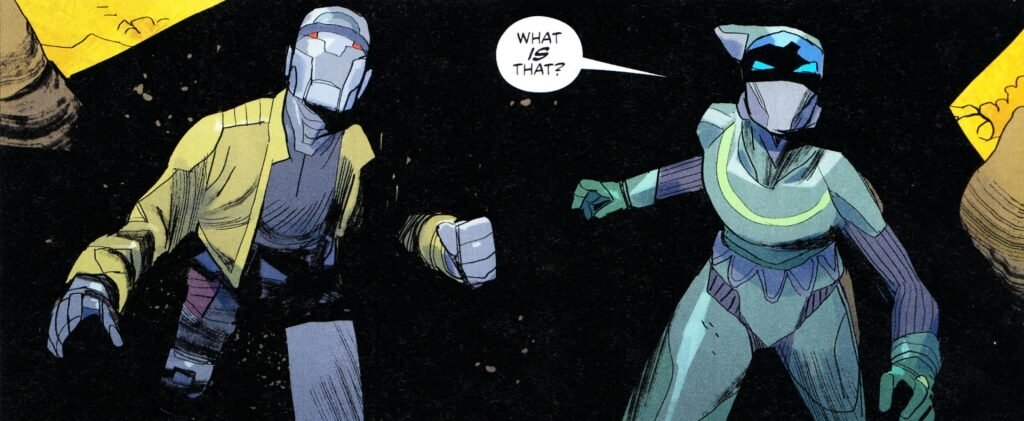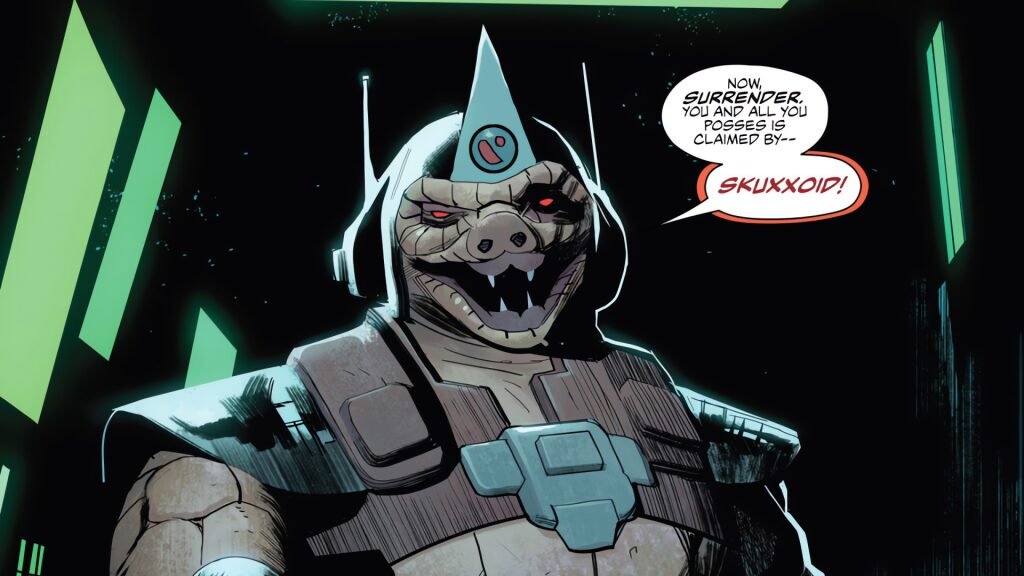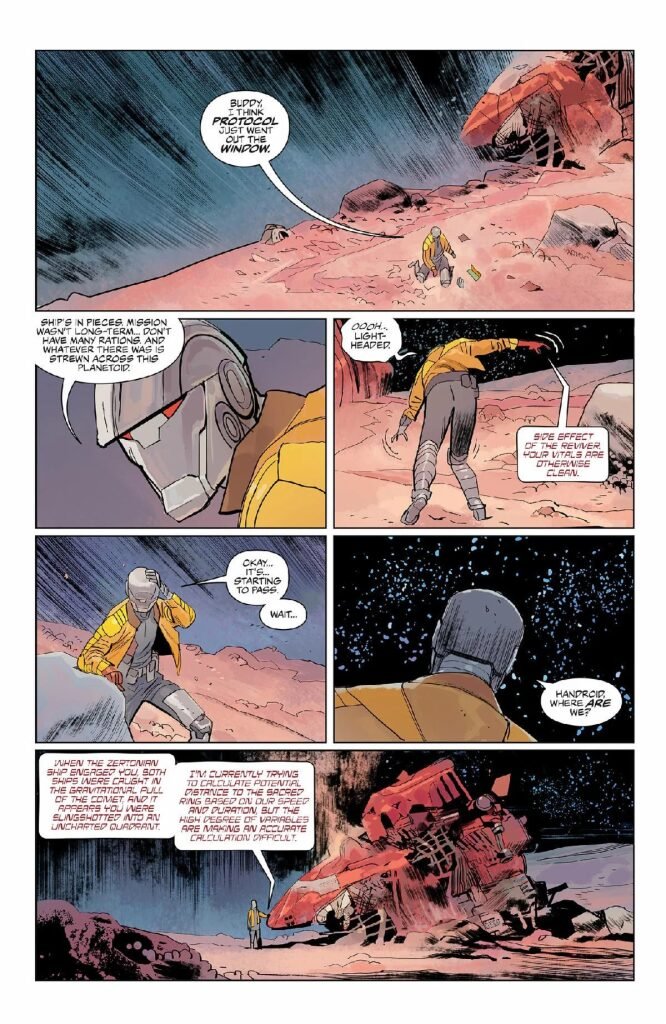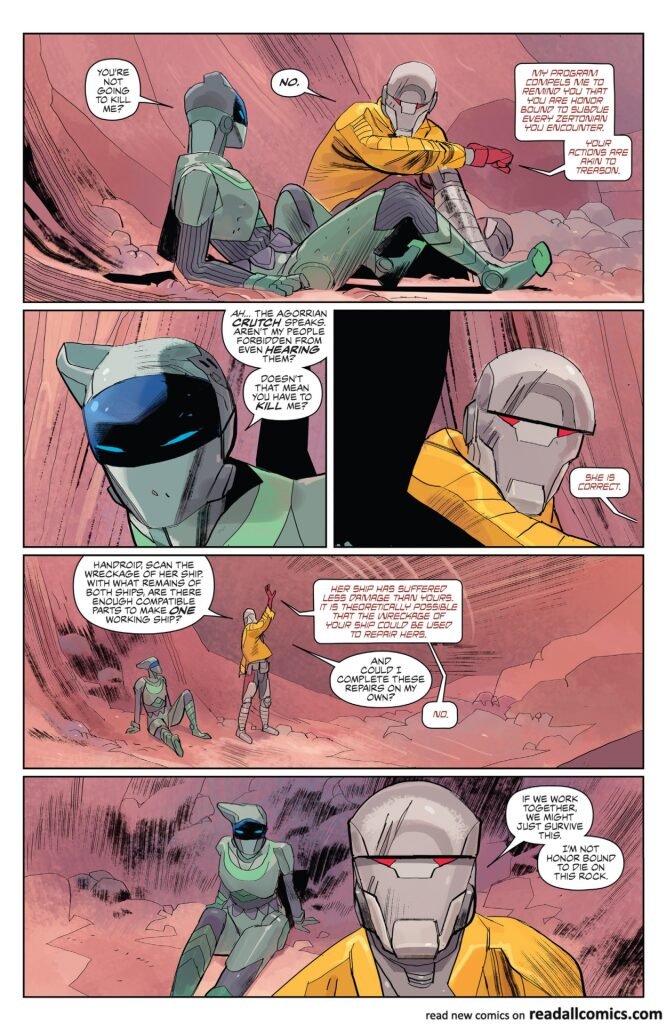Writer: Robert Kirkman
Artist: Lorenzo de Feleci
Image Comics / Sky Bound comics, 2023
American comic book professional Robert Kirkman has a formidable track record as the writer and creator of The Walking Dead, Marvel Zombies, Battle Pope, and Invincible. In Void Rivals, a new comic book published by Image Comics, Mr Kirkman is permitted by toy giant Hasbro to play with some of its most popular character concepts.
This is hardly the first time Hasbro have collaborated with a comic book company. Indeed, the company’s revenue is dependent upon licensing concepts ranging from Nerf guns to Peppa Pig. In respect of comic books, this financial model goes back decades. One example, raised by a reader whose fan mail to Void Rivals was published, is Rom. Marvel Comics had a long-standing arrangement with Hasbro (and before it, Parker Brothers) to produce a comic for a toy called Rom the Space Knight. This title was very successful, and lasted from 1979 to 1986. In 2016, IDW Publishing issued a new series of Rom’s adventures, lasting until 2020. Another toy, M.A.S.K. (also mentioned by a letter writer) was the subject of a comic book published by DC Comics from 1985 to 1987, before IDW Publishing acquired the rights in 2017. (Wikipedia otherwise lists other collaborations: List of comics based on Hasbro properties – Wikipedia.)
In Void Rivals, Mr Kirkman utilises the extremely popular Transformer characters and another Hasbro concept long the subject of comic book publications, G.I. Joe. (IDW Publishing lost rights to use these concepts in comic books at the end of 2022.) Mr Kirkman’s task is to integrate the two into a common universe.

Mr Kirkman’s efforts are not especially slick. The backdrop is a contest between two alien civilisations, the Agorrians and the Zertonians. They are in mortal combat with each other over scarce resources, and their cultures have evolved so that they find each other completely repellent. One of the Agorrians, Darak, crash-lands his spaceship on a deserted rock after a firefight in space with a Zertonian named Solila. They find themselves compelled to cooperate and rebuild their starship in order to survive. Along the way, they unexpectedly encounter a Transformer named Skyfire, an alien bounty hunter named Skuxxoid, and an alien octopus called a Quintesson. It evolves that the two societies exist on a severed Dyson ring called the Sacred Ring, each half apparently orbiting a black hole. No doubt the two have a common pedigree. The upper echelon of both civilisations are in cahoots. Darak and Solila discover many of their apprehensions about each other are false. Solila betrays Dark. The two by the end of issue 4 find themselves in prison together. There is something a little 1950s sci-fi about the lack of sophistication to the plot.

That might be forgivable. Simple space operas can contain wonderful characterisation, after all. But, sadly, the dialogue is clumsy. Dark urges his personal AI, embodied in a glove and called a “Handroid”, to informality:
“What? Where? Oh… the crash must have knocked me out. After all that, please… call me Darak”.
Darak has just crawled through sand with broken bones to an advanced medical kit which has miraculously restored his health. It is weird timing for introductions to a computer which is attached to his hand. The handroid responds:
“Protocol states I avoid addressing you by name as to not encourage familiarity or risk forming a bond.”
Why, other than to establish the handroid as the resident party-pooper? The handroid does not have much to say, other than repeatedly warning Darak not to do things, which Darak then goes and does, so as to demonstrate Darak’s revolutionary freedom of thought in a cloistered society. There is little finesse in that approach. Darak is an unruly character with a sense of humour, and we learn he has been disavowed by his father, the leader of the Agorrians. No doubt Darak as a deposed prince will come to lead a resistance against his father’s regime (hopefully no one will lose a limb). The best revolutionaries, after all, are disenchanted children.
Speaking of children, stuck on the space rock in issue 1, Solila and Dark initially wear helmets with full-face masks. Both of their cultures prohibit revealing their faces. They refer to each other in petty terms: “I don’t know that I’ll be able to work with you after seeing your hideous Agorrian face,” says Solila. Darak responds, “I’d rather look at your misshapen Zertonian face than… die”. It is like watching a pair of fourth-graders flirt in a school yard.

Artist Lorenzo de Felici does his best with his recognisable scratchy, but appealing style, and his detailed rendition of Skyfire was no doubt a crowd-pleaser.
Otherwise, none of it is good. We assume Mr Kirkman has a limited creative palette to work with as a consequence of Hasbro’s oversight.


